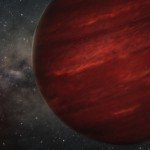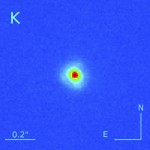W. M. Keck Observatory Press Release…
A team of researchers has discovered and photographed a gas giant only 155 light years from our solar system, adding to the short list of exoplanets discovered through direct imaging. It is located around GU Psc, a star with one-third the mass of the Sun and located in the constellation Pisces. See the article in The Astrophysical Journal.

A distant planet that can be studied in detail
The object was discovered using Gemini-South and followed-up with Gemini-North spectroscopy and CFHT photometry. Once Naud’s team had the entire spectrum, they realized the object had a very low temperature, with properties similar to substellar objects like brown dwarfs or planets.
One possibility was that the object had a peculiar spectrum simply from its youth, and that this had nothing to do with it being a binary, but the other tantalizing possibility was it was a binary planet, with one component being slightly warmer than the team derived from their analysis and the other component slightly cooler.
“This would have been the first ever planetary-mass binary, making our object even more of an oddity,” said Étiene Artigau, co-supervisor of Naud’s thesis and astrophysicist at the Université de Montréal. The team obtained Laser Guide Star Adaptive Optics observations using NIRC2 at Keck Observatory to determine it was a single planet.

“Planets are much brighter when viewed in infrared rather than visible light, because their surface temperature is lower compared to other stars,” Naud said
Knowing where to look
The researchers were looking around GU Psc because the star had just been identified as a member of the young star group associated with AB Doradus. Young stars (only 100 million years old) are prime targets for planetary detection through imaging because the planets around them are still flush with the heat of their formation and are therefore brighter. This does not mean that planets similar to GU Psc b exist in large numbers, said Artigau. “We observed more than 90 stars and found only one planet, so this is truly an astronomical oddity,” he said.
Astronomers do not directly measure the mass of a planet or star. Instead, researchers use theoretical models to determine their characteristics. The light spectrum of GU Psc b obtained from the Gemini North telescope in Hawaii was compared to such models to show that it has a temperature of around 800°C. Knowing the age of GU Psc due to its location in the AB Doradus group, the team was able to determine its mass, which is 9-13 times that of Jupiter.
“GU Psc b is a true gift of nature,” said says René Doyon, co-supervisor of Naud’s thesis and OMM Director. “The large distance that separates it from its star allows it to be studied in depth with a variety of instruments, which will provide a better understanding of giant exoplanets in general.”

